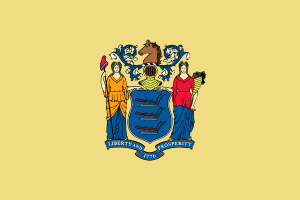History of state highways in New Jersey before 1927

New Jersey was one of the first U.S. states to adopt a system of numbered state highways. The Egan Bill (1916 state laws, chapter 285) designated the initial system of 13 routes:
- Route 1, Elizabeth - Rahway - New Brunswick - Hightstown - Trenton
- Route 2, Trenton - Burlington - Camden
- Route 3, Camden - Berlin - Egg Harbor City - Absecon
- Route 4, Rahway - Perth Amboy Asbury Park - Point Pleasant - Lakewood - Toms River - Absecon
- Route 5, Newark - Morristown - Denville - Dover - Hackettstown - Delaware Bridge
- Route 6, Camden - Westville - Mullica Hill; split at Mullica Hill for Pittsgrove - Bridgeton and Woodstown - Salem; connection Bridgeton-Salem
- Route 7, Hightstown - Freehold - Asbury Park
- Route 8, Montclair - Sussex - Unionville, New York
- Route 9, Elizabeth - Somerville - Phillipsburg
- Route 10, Paterson - Hackensack - Fort Lee Ferry
- Route 11, Paterson - Newark
- Route 12, Paterson - Denville - Dover - Hackettstown - Phillipsburg
- Route 13, New Brunswick - Princeton - Trenton
The Edge Bill (L. 1917 c. 14) went into more detail on funding, maintenance, and similar issues, and added two more routes:
- Route 14, Egg Harbor City - Mays Landing - Seaville - Rio Grande - Cape May
- Route 15, Bridgeton - Millville - Rio Grande
A sixteenth route was added by 1921:
- Route 16, Morristown - Somerville - Princeton
However, after 1921, the process was less coordinated, as local politicians tried to get their route built without concern for duplication of numbers. The State Highway Commission was not allowed to change the numbers; the best they could do was assign suffixes. Where multiple routes existed with the same number, suffixes of N and S were used for the northernmost and southernmost. Starting in 1923, various unnumbered routes were also assigned; none of these were taken over by 1927. Along with various modifications to the existing routes, the following additional numbered routes were assigned in 1923 (everything after 1923 was unnumbered):
- Route 17N, Newark - Hackensack - Suffern, New York (L. 1923 c. 5, 177, 181, 183, 184)
- Route 17S, Westville - Penns Grove (L. 1923 c. 199)
- Route 18, Camden - Mount Holly - Toms River (L. 1923 c. 184)
- Route 18N, Hoboken - Alpine (L. 1923 c. 197)
- Route 18S, Penns Grove - Woodstown - Pittsgrove - Malaga - Mays Landing - Pleasantville - Atlantic City (L. 1923 c. 181, 183)
- Route 19, Seaville - Pleasantville - Absecon (L. 1923 c. 182, 183)
- Route 20, Berlin - Haddonfield - Camden (L. 1923 c. 177)
- Route 20, Westville - Malaga - Millville (L. 1923 c. 182)
Construction and maintenance transfers began by 1917 with Route 13 (the Lincoln Highway, now Route 27) north of Kingston; the routes were marked by 1922.
In 1926, a partial renumbering was proposed to eliminate duplicates and assign a number to every route; this would have given the system numbers from 1 to 30. Instead, a total renumbering was adopted in 1927 as public law chapter 319. This system - the 1927 renumbering - assigned numbers from 1 to 12 in northern New Jersey, 21 to 28 roughly radiating from Newark, 29 to 37 from Trenton, 38 to 47 from Camden, and 48 to 50 in southern New Jersey. Portions of the pre-1927 routes that had been taken over or built, but were not assigned new numbers, kept their old numbers. These four routes - Route 4N, Route 5N, Route 8N and Route 18N - were all assigned the suffix N (as the only suffixed one to remain was 18N, and the others needed to be distinguished from the new routes of the same number).
See also
 U.S. Roads portal
U.S. Roads portal New Jersey portal
New Jersey portal- New Jersey State Routes
- 1927 New Jersey State Route renumbering
- 1953 New Jersey State Route renumbering